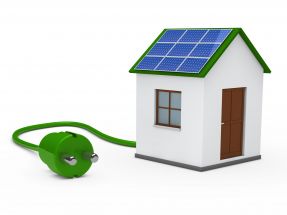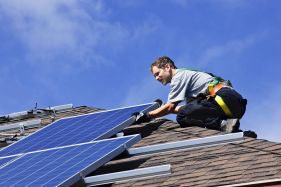Replacing a Roof with Solar Panels New Jersey
How does replacing a roof with solar panels work?
A roof replacement is a significant decision, one that you should take time to consider carefully before beginning the process. Once you’re sure that putting solar panels on your new roof is the right choice for you, it’s crucial to weigh your options.
One option is to remove the entire existing roof and replace it with an entirely new roof that incorporates solar panels. Solar panels can be mounted to almost any type of roof, from tile to asphalt shingle, and it’s possible to customize your installation with a degree of artistic creativity.

However, this approach is often the most expensive option. In addition to the new roof price, consider the cost of removing and disposing of your old roof. You may be able to recover some or all of these costs by selling your old roof as scrap metal.
A second option is to add a layer of solar shingles on top of your existing roof. Solar shingles are made from glass or plastic and have the look, color, size, and shape of conventional asphalt or tile shingles. Instead of being opaque like a regular roof, however, these shingles incorporate transparent photovoltaic panels that enable them to generate electricity while protecting your interior from the sun’s ultraviolet rays.
As with regular panels, you’ll need to maintain access to your roof for cleaning and maintenance. This means that you’ll have to carefully plan the layout of your solar shingles, ensuring that each row has a degree of overlap with its neighbors to provide a uniform appearance.
When it comes to replacing a roof with solar panels, there are a few things you should know.
There are a few things to think about before going solar roof replacement. These are the things that you need to take into consideration:
Assess the condition of your roof
Your existing roof may need repairs or replacement, and if so, this will increase the cost of an installation. You should consider any potential problems that could arise from replacing your roof before making your final decision.
Look into the different solar options
Solar shingles offer a distinct advantage over the traditional types of solar panels in that they blend in much more smoothly with the overall aesthetics of your roof. If this is an essential consideration for you, then solar shingles may be ideal. However, there are also significant drawbacks to consider when weighing your options. The former is generally more expensive to install than solar shingles and traditional panels, especially if you have an unconventional roof or require specialized repairs.
Do a proper cost analysis before replacing your roof
You’ll need to carefully consider your budget when planning to replace your roof with solar panels. If you select solar shingles, you may save money upfront, but the cost of repairs could negate this. With traditional panels, on the other hand, you’ll typically pay more upfront but enjoy a longer lifespan and lower maintenance costs in the future.
Consider all of your options before replacing your roof with solar panels
If you’re considering replacing your roof, don’t forget to look into solar shingles. They offer a more aesthetically pleasing alternative to traditional panels, though they typically come with higher installation costs and require customized repairs. You should also keep the condition of your roof in mind and give serious consideration to any damage that may complicate the installation process.
How much does it cost to replace a roof with solar panels?

The cost of replacing your roof with solar panels can vary widely depending on your choice of replacement. The following are some of the average costs associated with each option.
Replacing your roof with traditional solar panels involves removing your old shingles or tiles, installing the panels, and sealing off the seams between them. This is usually more expensive than adding a layer of solar shingles on top of your existing structure due to the added labor involved. In the United States, costs range from about $4 to $10 per square foot for a basic installation. According to the U.S. Department of Energy, however, total costs can be as much as 80% higher if your roof needs repairs or replacement before you can begin installing solar panels.
Replacing a roof with solar shingles may seem like the more affordable route. These panels are typically sturdier than solar tiles, making them better suited for areas that experience heavy wind or hail. This is reflected in the installation cost: while traditional panels can be as little as $4 per square foot, you’ll likely spend at least $21 to $25 per square foot for solar shingles.
The cost of replacing your roof with solar panels will vary depending on several factors, including its condition, the type of replacement you choose, and whether or not repairs are necessary. As a general rule, however, you should expect to spend between $4 and $10 per square foot for a basic installation.
How do you replace a roof with solar panels?
When you replace your roof with solar panels, you’ll remove your existing shingles or tiles and install the solar array in their place.
Install the new panels on top of your existing structure
The first step in replacing your roof with solar panels is to remove any existing shingles or tiles already in place. This can be done by hand using a flat bar, shovel, and pry-bar (for larger tiles) or attached using an automated mechanism (for shingles). Before you do anything, however, make sure that your roof is sound and won’t be compromised by the added weight of a solar array, especially if you live in an area where strong winds or hail are common.
You need to figure out how much space you have for solar panels
The next step in replacing a roof with solar panels is to find out how much space is available within your roof structure. This may require removing portions of your existing roof, though you can avoid this step if you’re confident that the panels will fit over the preexisting beams.
Connect the modules with electric cables
Once you determine how much space is available on your roof, you should measure the solar modules or shingles that you’ll be using to connect them with the electric cables. Measure each module or shingle to avoid excess waste when cutting them to size, and make sure that the wires are routed through your roof in a way that doesn’t present a problem with leaks or damage when it rains.

You have to seal the seams
Sealing the seams between the solar tiles or shingles is essential in replacing your roof with solar panels. You can choose from various products for this purpose, including butyl tape, silicone, and EPDM rubber strips.
Securely attach each tile or shingle
Once you’ve created a tight seal along the seams, you must attach each solar module or shingle within your roof. This can be done by hand using a rubber mallet and screwdriver, but it is recommended that you use a unique tool for this purpose. Ensure that each tile or shingle is securely attached to avoid coming off during heavy winds or rain.
Connect the array to your existing electrical system
Connect the solar array that you’ve installed within your roof to your preexisting electrical system. The wiring should be routed through the rooftop to match up with the electric cables on the outside. It is s recommended that you have an electrician do this part of the process for you since they are best suited to handle e preexisting electrical systems.
You need to get an inspection
The final step in replacing your roof with solar panels is to get an inspection for your newly installed system. This should be done by a professional trained in installing solar arrays, and you may need to present your plans before getting an official seal of approval on your work.
What are the advantages and disadvantages of replacing a roof with solar panels?
Advantages:
- Solar energy is a renewable resource that has no negative impacts on the environment.
- Installing solar panels on your roof can increase the value of your home since it doesn’t require any significant construction or installation work.
- The initial cost of installing solar panels is offset by how much electricity you save over time.
Disadvantages:
- Installing solar panels on your roof can be costly, though this can be offset by the amount of money you save on electricity.
- It may take a significant amount of time to recoup the initial cost of installing solar panels with how much energy they produce over time.
- The process of replacing your roof with solar panels is complicated.
Is it possible to claim the federal solar tax credit for roof replacement expenses?
Although not typically considered a solar system, the federal tax credit for “energy-efficient” homes is available for your roof replacement project. A typical example of this would be replacing your existing asphalt shingle roof with a metal roof. In this case, you’d have to spend more than half the cost of materials on building envelope-related improvements such as insulation, air sealing, and new windows.
This credit is taken all at once during the year you performed the work. This is a good deal for homeowners planning to replace their roofs and want to take advantage of this federal incentive, especially since it doesn’t require any special certification or follow-up inspections.
Who is Eligible for the Federal Solar Tax Credit for Roof Replacement?
You are eligible for this solar tax credit if you meet all of the following conditions:
- You must be the homeowner of the building in which you will install solar panels. You cannot be acting on behalf of a landlord or any other party.
- You must not have requested any reimbursements or allowances for the materials used in your project. This means that you can’t buy solar panels through your home builder, since they will usually offer discounts if you allow them to use their preferred installation companies.
- You also cannot claim any discounts that you receive from your local solar panel retailer since this would be considered a rebate.
In addition, you can’t take advantage of this tax credit if you are a co-owner of the property in question or if your building was not considered to be your primary residence.
Frequently Asked Questions
Do you have to remove solar panels to replace a roof?
No. If the solar panels are installed over your preexisting roof, you don’t need to remove them to replace your roof.
What is required by law when replacing my roof?
In most states, you are required by law to apply a weatherproof barrier over your new roof before attaching solar panels. This is intended to prevent water from leaking onto the insulation below. However, this barrier can be made out of wood, metal, polymers, or even rubber.
Do I have to replace my entire roof?
No, you don’t have to replace your entire roof. You can install the new shingles over your existing rooftop, which will provide all of the benefits of a traditional solar system. However, this means that you will not be able to claim the tax credit associated with roof replacement expenses at the end of the year.
How long do I have to claim my federal solar tax credit for roof replacement?
It depends on the type of structure in which you reside. If your home is a primary residence, you must take the full credit for the year you installed your solar panels, as stated above.
What type of solar roofing is eligible for the federal solar tax credit?
All types of solar roofing qualify as long as they are installed on a building that you own and occupy as your primary residence. This means that even solar shingles are eligible.
What are the advantages of replacing my roof with solar shingles?
A significant advantage of solar shingles over traditional panels is their aesthetic appeal. Solar shingles blend in seamlessly with your existing roof, making them difficult for anyone (including energy companies) to detect.
Can you do roof restoration with solar panels?
You can. If your solar panels are not producing as much electricity as they did when installed, it may be time for a roof restoration process. You can restore the effectiveness of your solar arrays by adding additional shingles or other features that will allow you to capture more sunlight and therefore produce more energy.
Why is it better to replace your roof before installing solar panels?
It’s always better to get new solar panels installed with a new roof. This ensures that the connection between your newly installed array and your preexisting electrical system is not compromised by loose or damaged shingles or tiles on your rooftop.
How long does it take to replace a roof with solar panels?
Replacing a roof with solar panels varies, but it usually takes about a whole day to remove the old roof and one or two days to install the new roof.
Summary – Replacing a roof with solar panels
If you are replacing your roof with solar panels, you need to assess the condition of your roof first. While installing solar tiles over existing tiles or shingles is possible, it’s best to remove any loose or damaged tiles before installing them so that they don’t become a hazard during installation. Solar arrays should be installed in a way that matches up with the preexisting electrical system on your roof, and you need to have an inspection done after installation before you can legally connect them to your home.
When replacing your roof with solar panels, the benefits outweigh the initial costs of considering how much energy they produce over time. In addition to having renewable energy, solar panels can also increase the value of your home. Installing them with an existing roof is straightforward and fast, and you should consider whether or not it’s time to get a roof restoration done if your array is no longer producing as much electricity as it did when they were installed.
